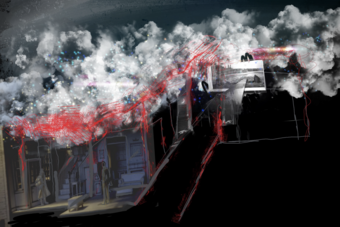The Composition of Latinx Aesthetics
Whenever I am asked why I don’t have an accent, I say that I have an ear for music. Languages are a type of music, and communication an intricate composition. Recently, most things sound a bit “off” to my ear: a bit sharp, a bit flat, a bit muddled or loud. But the most problematic are the massive orchestrations of conversation that, having no true harmony, clash against each other with notes of expectations and givens, and the brass of ignorance—making it truly difficult to communicate with one another. That type of dissonance sounds unharmonious to my ears. It’s too chaotic. But the sound, like true chaos, comes together at brief points, upon which discerning ears perk in hope of getting a short snippet of the larger composition. It’s in that disturbing collision that listening begins: suddenly we are invested, suddenly we care to find harmony. Listening is a generous act. It engages our senses in beautiful ways and makes the possibility for harmony grow exponentially.
To me, aesthetics is about semiotic language—so that both ear and eye are undeniably conversing.
I remember such cacophony at the first Latinx Theatre Commons (LTC) First National Convening, held in Boston in 2013. At the time, the LTC was little more than a skeleton composition—with a stellar overture, no real denouement, and all the energy for a movement. Have you ever given percussion instruments to a room full of people? It takes a long time to find a unified rhythm. It’s like when a crowd of people decide to “clap to the beat” and then after two seconds, the crowd is inevitably off beat. That is because when we value our input—our clap, our shaker, our rhythm—above the whole, our instrument fails in that which requires selflessness: harmony. It’s true for music and rhythm, and in my experience, also for a roomful of theatremakers. Our initial, ardent attempts at orchestrating meaning were so noisy, that I hid behind a clown nose until I could force myself to listen fully to the notes that I knew I could organically harmonize with.
The LTC’s growing success, in my opinion, is due to the ability to discern the points where our voices harmonize, and not to distinguish, or diminish, the difference and dissonance in our individual tones. Even when the conversation loops (at probably every convening since 2013, the kryptonite question is a version of “What is Latinx Theatre?”), the penchant for listening grows a little more. It reminds me of why we visit family on Sunday.
I don’t hide anymore. It has become easier to listen to identity, politics, meaning, and language. However, I am still searching for a different type of harmony. Perhaps I have not been in the right rooms, or my listening is biased to the trebles—but I’ve yet to hear the conversations around the Latinx aesthetics that seek a balance between the consonant and dissonant sounds.
To me, aesthetics is about semiotic language—so that both ear and eye are undeniably conversing. But aesthetics is one of those words that can sometimes reshape itself under the tool of the definer. Aesthetics is not only an engagement of the senses, but also the discipline that investigates the conditions of beauty in art and in nature: It is an individual’s particular way of understanding art and beauty. So how can many instruments possibly harmonize when there are so many particular ways of understanding art and beauty?
For four years, I have witnessed and taken part in the compositional movement of the LTC. And our music is not only taking form, but it is encouraging other movements—modeled and inspired by the LTC. Anyone who thinks that the Commons is a given, that it is easy, that it is instant harmony and perfect—it is not. It has taken work and plenty of careful listening for us to find moments of harmony, of being in tune, and of solidifying those compositions that are unmistakable harmonious, to form the strong tenants that may support the movement for years to come.
While we find harmony in sage, in ritual, in kindness, and in the affect of beauty, an LTC convening is just the beginning of a larger task of tuning in.
November 2-19, 2017, is the 2017 Encuentro de Las Américas: a festival of productions from all of the Américas produced by the Latino Theater Company that culminates in a weekend gathering, the 2017 LTC International Convening, November 9-12, hosted by the Latinx Theatre Commons. I can’t wait to witness this collision of cultures, accents, and languages. I am certain that the senses, the colors, and the shapes of tragedy, that the choreography behind the political animal, and the melancholic underscore of the naturally subtle, will surface. And perhaps the melody will not be about “What is…” but rather “What does it do…”
To me, Latinx aesthetics is about continuously seeking to harmonize with the notes that resonate on the philosophy string that leads us away from the psychological spool of over-individualized-character, and reveals the view of a larger fabric. It’s about reflecting on the notes that play “nows and news,” and the exploration of the symbolic and emotional, not just the rational and the logical. Above all, it’s about harmony of spirit, global mindfulness, acute body politic, and a fully human approach to otherness. To me, that is what makes up my Mexican aesthetic—and perhaps, that is what makes my work Latinx.
Latinx aesthetic should continue to be a definition in action. And while we find harmony in sage, in ritual, in kindness, and in the affect of beauty, an LTC convening is just the beginning of a larger task of tuning in. But it is a collective embrace on the wake of a discordant reality. I encourage all of us to trust that even when things may sound a bit off, we can start a conversation by tuning in to a note that sounds different, and adjusting our own to make a song that moves others.











Comments
The article is just the start of the conversation—we want to know what you think about this subject, too! HowlRound is a space for knowledge-sharing, and we welcome spirited, thoughtful, and on-topic dialogue. Find our full comments policy here
Thank you for this, Georgina. In this period of redefining the narrative of Latinx Theatre, these conversations are critical for us to recognize the work that came before us, what is happening today, and how we as Latinx artists can continue to push beyond our own definitions to create something new.
Well said!
Georgina this is exquisite. Your seeking for the soul of our gatherings really speaks to me. I continue to be in awe of you and your artistry. Let's listen together for those deep commons messages waiting to break through. Your hermana in expanding our aesthetics and collective power to harmonize.
Gracias! Let us listen.
What a pleasure to read you, Georgina. Beautiful and inspiring essay.
Y que continue la platica. Un beso, Jose.
Beautiful essay, Georgina. I'm really looking forward to seeing how this conversation plays out at the Encuentro de las Americas this fall.
Gracias Trevor and to all the editors!